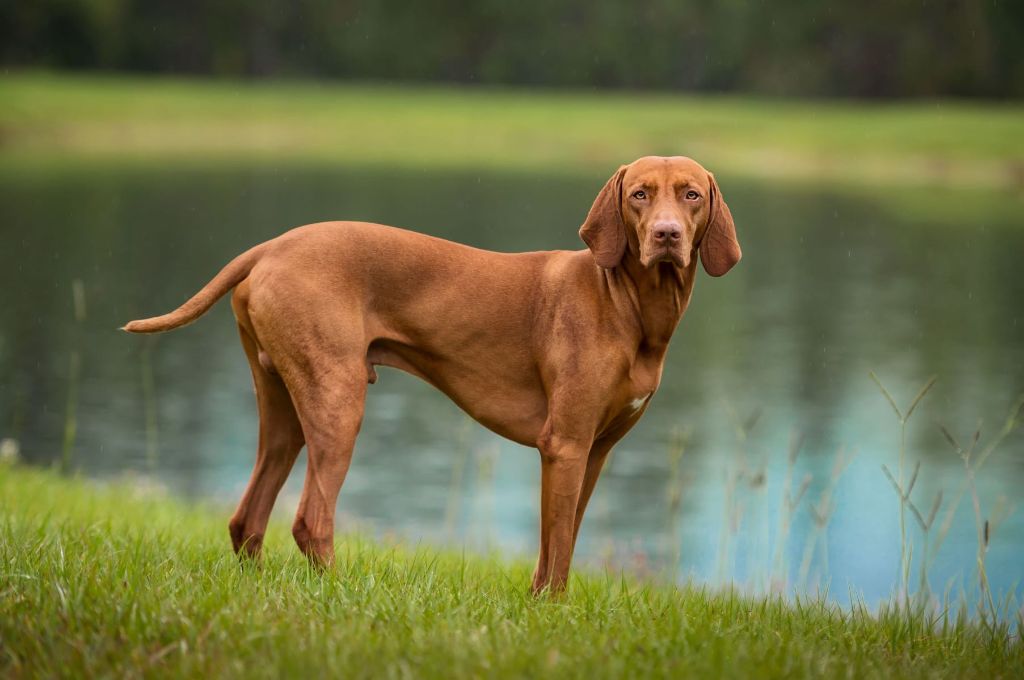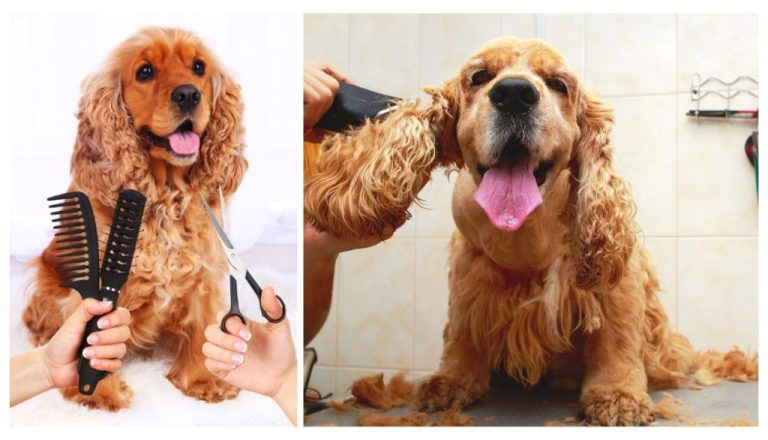Vizsla: Traits And Temperament Of A Sporting Dog
The Vizsla is an ancient Hungarian sporting dog breed with a distinguished history. Originally bred to be an all-around hunter and retriever, the Vizsla excels as both a pointer and retriever on land and water (Source).
The breed dates back to at least the 8th century when Magyar tribes brought Vizsla-type dogs with them as they invaded the Carpathian Basin. Over the centuries, the Vizsla was refined into the ultimate versatile hunting companion (Source).
Despite facing near extinction twice, first after World War I and again after World War II, the Vizsla has rebounded thanks to dedicated breeders. Today, the Vizsla is known for its affectionate and lively temperament, natural hunting abilities, and devotion to family.
Appearance
The Vizsla has a lean, athletic build and a short, smooth coat. According to the American Kennel Club (AKC), male Vizslas stand between 22-24 inches at the shoulder, and females are between 21-23 inches tall (AKC). The breed standard weight for males is 55-66 pounds, while females are 44-55 pounds.
Vizslas have a distinctive golden rust coloring, and their coats are often described as shimmering gold. The skin and coat color on a Vizsla should blend perfectly. Puppies are often born very dark and lighten to amber gold by the age of 1-2 years old. White markings on the chest and toes are common but not desired in the show ring. The AKC breed standard only allows rust or golden rust colors (AKC).
The Vizsla has a short, smooth coat that lies close to the body and does not have an undercoat. The coat is described as velvety to the touch. Minimal grooming is required thanks to the Vizsla’s close coat, and occasional brushing and bathing is typically all this breed needs (Dogtime).
Temperament
Vizslas are known for having a loyal, affectionate, energetic, gentle, and intelligent temperament. They form strong bonds with their owners and aim to please. According to the American Kennel Club, Vizslas are “natural hunters” with a “friendly, gentle, and tolerant” personality. Their energetic nature makes them an active companion.
Vizslas thrive when they can be close to their owners and families. They are highly attached and want to be involved in all activities. With proper socialization and training, Vizslas generally get along well with other dogs, pets, and children. However, their strong desire for attachment means they can suffer from separation anxiety if left alone for long periods. Providing plenty of exercise, stimulation, and affection helps bring out their best gentle and affectionate qualities.
Activity Level

The Vizsla is an extremely active and energetic dog that requires lots of daily exercise and stimulation. This high-energy sporting breed needs a minimum of 60-90 minutes of vigorous activity per day according to experts. Without sufficient activity, Vizslas can become anxious, destructive, or develop other behavioral issues.
Vizslas have been bred to hunt and run for hours alongside their owners. They thrive when given opportunities to run free in wide open spaces and need a large fenced yard to burn off energy. Long daily walks, jogs, hikes, swimming, or retrieving games are great ways to meet their exercise requirements. Vizslas also excel at canine sports like agility, flyball, dock diving and field trials. Owners need to be prepared to provide their Vizsla with intense daily exercise for their entire lifespan.
Due to their high energy, Vizslas are not recommended for sedentary owners. They need engaged owners willing to provide vigorous outdoor activities daily. Vizslas that don’t get enough exercise can become hyperactive and destructive. Making sure to meet their exercise needs is key to having a well-behaved and happy Vizsla.
Trainability
Vizslas are highly intelligent and eager to please, making them very responsive to training based on positive reinforcement techniques. According to the AKC, “Vizslas need consistent, positive training, starting in puppyhood. They are highly intelligent, curious, and sometimes manipulative, so owners need to earn their respect by setting clear rules and training the dog in a confident, consistent way.”
Vizslas want to work closely with their owners and will apply themselves eagerly to any task or activity. Their energetic nature and desire to be busy makes them well-suited for activities like agility, hunting, field trials, and obedience competitions. Proper training and socialization from an early age will ensure that the Vizsla’s enthusiasm and drive is channeled in a positive way.
While intelligent and willing to learn, Vizslas can be sensitive and do not respond well to harsh scolding or punishment-based training methods. Positive reinforcement using treats, praise, and play will yield the best results. Establishing yourself clearly as the pack leader and being firm, but never angry, will earn a Vizsla’s respect.
Health
Vizslas are generally a robust breed with few health issues. However, there are some conditions they are prone to that owners should be aware of.
One common condition is hypothyroidism, which causes a slowed metabolism. Symptoms include weight gain, hair loss, and lethargy. This is manageable with daily medication.https://ahcfargo.com/client-resources/breed-info/vizsla/
Vizslas can also suffer from eye issues like progressive retinal atrophy, which causes blindness over time. Responsible breeders will screen breeding dogs for this condition.https://canna-pet.com/articles/vizsla-health-problems/
As athletic dogs, vizslas are prone to orthopedic issues like hip dysplasia later in life. Maintaining a healthy weight and providing joint supplements can help.https://gallant.com/blog/5-common-vizsla-health-concerns/
With proper care and barring accidents, vizslas generally live 10-14 years. Keeping them active and fit will help maintain their quality of life into their senior years.
Nutrition
Vizslas have unique dietary requirements due to their high energy levels and lean body composition. They need a nutritious, high-quality diet to fuel their active lifestyle and maintain a healthy weight.
According to Vizsla – Dog Feeding Guide, the average Vizsla requires 1,100 to 1,700 calories per day depending on their age and activity level. Puppies may need up to 2,200 calories per day. It’s important not to overfeed Vizslas as they are prone to becoming overweight.
The best diet for a Vizsla contains high amounts of animal-based proteins like chicken, beef, fish, or eggs. Protein should make up at least 25-30% of their total calories. Vizslas also thrive on diets rich in omega fatty acids from fish, coconut oil, and other healthy fat sources according to Best Dog Food for Vizslas.
When choosing a commercial dog food, look for high-quality ingredients with meat or fish as the first ingredient. Avoid fillers like corn, wheat, and soy. Consider feeding a raw or homemade diet rich in lean proteins and vegetables under the guidance of your veterinarian.
Grooming
Vizslas have short, smooth coats that don’t require much grooming. Weekly brushing with a soft brush or rubber grooming mitt is usually sufficient to remove dead hair and distribute skin oils (source). Vizslas shed a moderate amount, especially during seasonal changes in the spring and fall. Daily brushing during shedding seasons can help keep loose hair under control.
Trim nails as needed, usually every 2-4 weeks. Check and clean ears regularly to prevent infections. Brush teeth frequently with a vet-approved dog toothpaste. And be sure to bathe your Vizsla just when necessary – too frequent bathing can dry out the skin (source).
Overall, the Vizsla’s short coat is easy to care for with minimal grooming needed.
Puppy Care
Proper care in the early stages of a Vizsla puppy’s life is crucial for developing a well-adjusted and healthy adult dog. Vizsla puppies need extensive socialization and training, plenty of exercise, and vigilant monitoring of their health.
Socializing Vizsla puppies involves positive introductions and exposure to many people, places, sights, sounds, and other animals. This helps avoid shyness or aggression later in life. Start socialization as early as 7-8 weeks old, and continue exposing the puppy to novel experiences. Puppy kindergarten is highly recommended. Socialization Tips for Vizsla Puppies
Begin basic obedience training around 8-12 weeks old using positive reinforcement. Vizslas are intelligent and respond well to training when started young. Practice commands like sit, stay, come, down, heel. Having good leash manners will also be important for walks. Take training classes or work privately with an experienced trainer. Vizsla Obedience Training Recommendations
Vizsla puppies have bountiful energy and need 60+ minutes of vigorous exercise every day as they grow. Take them for frequent walks, play interactive games like fetch, or allow supervised off-leash running in a safe area. Avoid too much repetitive exercise while puppies are still developing joints and bones.
Monitor your Vizsla puppy’s health closely, especially for common issues like diarrhea, ear infections, or hip dysplasia. Keep up with deworming and vet visits for vaccinations. Feed high-quality puppy food appropriate for large breed dogs. Track weight gain, and adjust portions to maintain ideal body condition.
Finding a Vizsla
Vizslas are high energy dogs that demand a lot of attention and exercise. Because of their needs, it’s important to find a responsible Vizsla breeder or rescue organization. Reputable breeders focus on health and temperament, not just aesthetics. They perform all recommended health tests and carefully screen potential buyers. Expect to pay $1,500-$2,500 from a breeder. Adopting an adult Vizsla from a rescue may cost $100-$500.
The American Kennel Club has a marketplace with reputable Vizsla breeders. The Vizsla Club of America also provides a breeder referral list. Make sure any breeder does OFA hip certifications, thyroid testing, and eye exams. Ask to see pedigree information and meet the puppy’s parents.
Another option is adopting a Vizsla from a rescue organization. Sites like Petfinder.com list Vizslas available for adoption nationwide. Rescued dogs may be housetrained and socialized. Be prepared for an adoption fee, application, home visit, and contract. With patience, you can find your perfect Vizsla companion.





